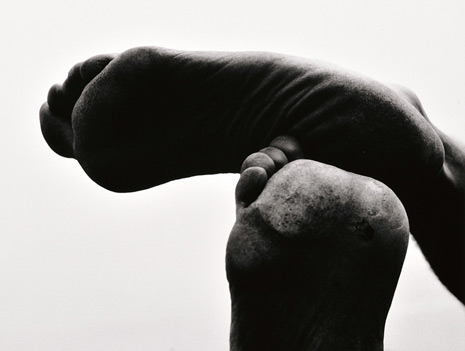Aaron Siskind
(1903- 1991)
- View Aaron Siskind Biography -
It is true that many people have photographed material similar to Siskind’s walls (a testament to his influence), but Siskind’s photographs have never been surpassed for sheer presence, power and continuous experiential possibilities.
-Carl Chiarenza
Aaron Siskind Biography
Influential as both a photographer and a teacher, Siskind made his first earnest attempts at photography in 1931/32. Moved by documentary photographs on display in New York City at the Film and Photo League (the forerunner of the Photo League), he joined the group and became active in the production of such projects as “Harlem Documentary” and “Portrait of a Tenement.” However, almost from the beginning a certain dissonance existed between the documentary and social-political goals of the League and Siskind’s emerging preoccupation with formal and esthetic concerns. Siskind, later recalled, “for some reason or other there was in me the desire to see the world clean and fresh and alive, as primitive things are clean and fresh and alive. The so-called documentary picture left me wanting something.”
In the early 1940’s, a major change took place in his work. Siskind left the league and thereafter worked in an increasingly abstract, personal and contemplative mode. He photographed organic objects – for example, – rocks – as flat shapes on the surface of the picture plane, rather than as objects with the pictorial illusion of possessing three dimensions. “For the first time in my life, subject matter, as such, had ceased to be of primary importance. Instead, I found myself involved in the relationships of these objects, so much so that these pictures turned out to be deeply moving and personal experiences.”
Siskind also photographed walls, portions of signs, graffiti, peeling posters, and other objects; his primary interest was in the flat graphic messages that they contained. At first his most sympathetic audience consisted of abstract expressionist painters he knew, such as Willem de Kooning and Franz Kline, who understood the problems of space, line, and planarity that he was addressing. But in time the new subject matter that Siskind delineated began to be explored by other photographers. Carl Chiarenza wrote, “It is true that many people have photographed material similar to Siskind’s walls (a testament to his influence), but Siskind’s photographs have never been surpassed for sheer presence, power, and continuous experiential possibilities”. (Photographs of Aaron Siskind)
In 1948, he met Harry Callahan, who brought him to The Institute of Design (New Bauhaus) in Chicago in l950 to teach photography. Siskind became head of The Department of Photography at the Institute, and in 1963 he was one of the founding members of the Society for Photographic Education. From 1971 – l976 he served as a faculty member at The Rhode Island School of Design.
The decisive shift in his work from the socially-oriented documentary form championed by the Film and Photo League to a highly modernistic belief in the photograph as “a new object to be contemplated for its own meaning and its own beauty” is one of the benchmarks in the evolution of mid-20th century art photography.



